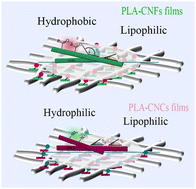Preparation of nanocellulose by a biological method from hemp stalk in contrast to the chemical method and its application on the electrospun composite film†
Abstract
In this study, CNFs were provided by an efficient, unmodified, and clean biological method with enzymes and a small amount of alkali, compared to the CNCs with the chemical method involving a strong acid. To provide an accurate targeted selection for future applications, we made the following comparison by analyzing the differences in the preparation method, performance, and application performance of the two nanocelluloses. The result of this study indicated that CNFs and CNCs exhibited a crystallinity index of 58.2 and 83.5%, respectively. CNFs had a mean length (L) of 192.3 nm and a diameter (D) of 1.9 nm, and the average L and D of CNCs reached 123.6 nm and 3.7 nm, respectively. The solution viscosity of CNFs and CNCs reached 7.46 Pa s and 1.91 Pa s, respectively. CNFs and CNCs exhibited zeta potential values of −88.26 mV and −26.40 mV, respectively. The electrospun composite film of PLA–CNFs and PLA–CNCs achieved water contact angles of 138.7 and 34.5°, and the water–oil contact angle reached 24.7 and 30.5°, respectively. The breaking strength of PLA–CNFs and PLA–CNCs reached 96.07 cN and 163.23 cN, and the break elongation followed an order of PLA–CNCs (32.16%) < PLA–CNFs (34.70%). In brief, CNFs can make the composite membrane hydrophobic and with superior extension, and CNCs can make the composite membrane hydrophilic and enhance its strength. Both the composite films conformed to the non-toxic standard, and the PLA–CNFs film more significantly contributed to the cell growth, which is expected to serve as a medical material.



 Please wait while we load your content...
Please wait while we load your content...